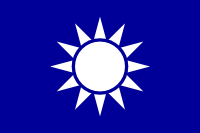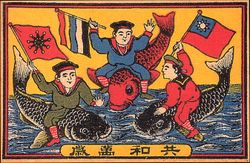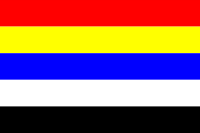Flag of the Republic of China
2007 Schools Wikipedia Selection. Related subjects: General Geography
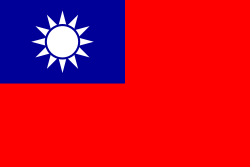
The flag of the Republic of China is red with a dark blue canton bearing a white sun with 12 triangular rays. This flag was adopted as the flag of the ROC Navy from 1912 to 1917. The Kuomintang (KMT) then adopted the flag as the national flag of the Nanjing government following Yuan Shi-kai's demise, with the Navy flag replaced by the canton, identical to the KMT flag.
The National Flag of the Republic of China ( Traditional Chinese: 中華民國國旗; pinyin: Zhōnghuá Mínguó guóqí) is a well-known symbol of the Republic of China (ROC), which since 1949 has been based on the island of Taiwan. It is commonly referred to in Chinese as Blue Sky, White Sun, and a Wholly Red Earth ( Traditional Chinese: 青天、白日、滿地紅; pinyin: qīng tiān, bái rì, mǎn dì hóng) to reflect its attributes. This design was first used in China by the Kuomintang (KMT) in 1917 and made the official flag of the ROC in 1928.
The current use of the flag is considered by some to be controversial due to the dispute over the political status of Taiwan. Within Taiwan, the flag is widely used as a national flag though there is controversy over its appropriateness. It is actively embraced as a symbol by Chinese reunification supporters as a historical link with mainland China, while a number of Taiwan independence supporters shun the flag for mainly the same reasons. Its use has been opposed by the People's Republic of China (PRC) because it suggests the continued existence of the ROC, which the PRC regards as defunct and to have been succeeded by the PRC in the Chinese Civil War. However, since the early 2000s, the PRC has had a more favorable view toward the flag, as it began to see the use of the flag in Taiwan as symbolizing a connection between Taiwan and mainland China, and news media in the PRC have often criticized supporters of Taiwanese independence for attempting to replace the flag.
Though the flag of the Republic of China is commonly known in English as the flag of Taiwan (as the ROC is often referred to as "Taiwan"), this term is not commonly used in Chinese as some of the current symbolism and controversy can only be understood if one realizes that it is not officially the "flag of Taiwan" but of a Republic that only assumed the administration of Taiwan in 1945 and moved its government there in 1949. This distinction is very important in Taiwanese politics.
History
The canton (upper corner on the hoist side) originated from the " Blue Sky with a White Sun" flag (青天白日旗, qīng tiān bái rì qí) designed by Lu Hao-tung, a martyr of the Republican revolution. He presented his design to represent the revolutionary army at the inauguration of the Society for Regenerating China, an anti-Qing society in Hong Kong, on February 21, 1895. This design was later adopted as the KMT party flag and the Coat of Arms of the Republic of China. The "red earth" portion was added by Sun Yat-sen in winter of 1906, bringing the flag to its modern form. Although the ROC national flag is based on the KMT party flag, the star in the KMT is somewhat different in that the party flag has shorter points. This is a detail which is very little known even among residents of Taiwan.
During the Wuchang Uprising in 1911 that heralded the Republic, the various revolutionary armies had different flags. Lu Hao-tung's "Blue Sky with a White Sun" flag was used in the provinces of Guangdong, Guangxi, Yunnan, and Guizhou. In Wuhan, a flag with 18 yellow stars was used to represent the 18 administrative divisions at the time. In Shanghai and northern China, a "Five-Colored Flag" (五色旗, wǔ sè qí) ( Five Races Under One Union flag) was used of five horizontal stripes representing the five major nationalities of China: the Han (red), the Manchu (yellow), the Mongol (blue), the Hui (white), and the Tibetan (black).
When the government of the Republic of China was established on January 1, 1912, the "Five-Colored Flag" was selected by the provisional Senate as the national flag. The "18-Star Flag" was adopted by the army and the modern flag was adopted as a naval ensign. Sun Yat-sen, however, did not consider the five-colored flag appropriate, reasoning that horizontal order implied a hierarchy or class like that which existed during dynastic times.
After President Yuan Shikai assumed dictatorial powers in 1913 by dissolving the National Assembly and outlawing the KMT, Sun Yat-sen established a government-in-exile in Tokyo and employed the modern flag as the national ROC flag. He continued using this design when the KMT established a rival government in Guangzhou in 1917. The modern flag was made the official national flag on December 17, 1928 after the successful Northern Expedition that toppled the Beijing government, though the Five-Colored Flag still continued to be used by locals in an unofficial capacity. One reason for this discrepancy in use was lingering regional biases held by officials and citizens of northern China, who favored the Five-Colored Flag, against southerners such as the Cantonese Sun Yat-sen.
During World War II, the invading Japanese established a variety of puppet governments using several flag designs. The "Reform Government" established in March 1938 in Nanjing to consolidate the various puppet governments employed the Five-Colored Flag. When Wang Jingwei was slated to take over the Japanese-installed government in Nanjing in 1940, he demanded to use the modern flag as a means to challenge the authority of the Nationalist government in Chongqing under Chiang Kai-shek and position himself as the rightful successor to Sun Yat-sen. However, he added a triangular yellow pennant on top with the slogan "Peace, Anti-Communism, National Construction" (和平反共建國, Hépíng fǎn'gòng jiàn guó). As a compromise with the Japanese (who did not want to use the pennant at all) this was used outdoors only and entirely discontinued in 1943 leaving two rival governments with the same flag, each claiming to be the legitimate Nationalist government of China.
The flag was specified in Article Six of the 1947 Constitution, but was banned in mainland China after the Communist victory in 1949, save in historical venues such as the President's Palace in Nanjing.
On October 23, 1954, the National Emblem and National Flag of the Republic of China Act (中華民國國徽國旗法, Zhōnghuá Mínguó guóhuī guóqífǎ) was promulgated by the Legislative Yuan to specify the size, measure, ratio, production, and management of the flag. The details of the flag specified in this legal document are taught in the mandatory Scout classes held in Taiwanese junior high schools.
Symbolism

In the "Blue Sky with a White Sun" flag of Lu Hao-tung, the twelve rays of the white Sun symbolize the twelve months and the twelve traditional Chinese hours (時辰, shíchén), each of which corresponds to two modern hours (小時, xiǎoshí, literally: "little shí"). Sun Yat-sen added the "Red Earth" to the flag to signify the blood of the revolutionaries who sacrificed themselves in order to overthrow the Qing Dynasty and create the ROC. Together, the three colors of flag correspond to the Three Principles of the People:
- White represents the people's livelihood;
- Blue represents democracy; and
- Red represents nationalism.
The blue-and-white canton of the ROC flag is used as the party flag of the KMT. The flag has developed a great deal of additional symbolism due to the unique and controversial political status of Taiwan. At one level, the flag represents a clear symbol that Taiwan is not governed by the same government as Mainland China, as this flag is different from the flag of the People's Republic of China (PRC).
At the same time, because it was formerly used as the flag over all of China, the flag has become a symbol of continuity with the ideals of the Chinese nationalism and Chinese reunification movements, and has become a symbol of a connection both historical and current with mainland China. In addition, the flag is derived from the seal of the KMT, and the colour of the field of the flag is associated with the KMT party colors.
Some Chinese see the flag as an expression of Chinese nationalism and pride combined with simultaneous disapproval for the current communist regime. Additionally, the flag may symbolise identification with, and admiration for the political thoughts of Sun Yat-sen, and his Three Principles of the People.
One irony is that given the association of the flag with Chinese nationalism in opposition to Taiwan independence, the ROC flag has found an unexpected ally in the People's Republic of China. The PRC has criticized Taiwan independence groups for wishing to change or abolish the ROC flag, and has implied that legal steps to do so would bring a strongly negative reaction from the PRC.
However, the presence of the ROC flag in Taiwan also distinguishes the fact that Taiwan and ROC territorial islands elsewhere fall under jursidiction of a government separate from that of mainland China, the People's Republic of China. The hoisting of the ROC flag is even advocated by the most extreme Taiwanese independence supporters, such as Taiwan Solidarity Union members when emphasizing the separate and independently governed systems and territories of the Republic of China (Taiwan) and the People's Republic of China on the mainland.
Uses
In the early years of the Republic, under the KMT's political tutelage, the flag shared the same prominence as the KMT party flag. A common wall display consisted of the KMT flag perched on the left and the ROC flag perched on the right, each tilted at an angle with a portrait of Father of the Nation Sun Yat-sen displayed in the centre. For the summits held between the KMT and Communist Party during the Chinese Civil War, the ROC flag was displayed at an equal position to the flag of the Chinese Soviet Republic (Jiangxi Soviet). Later, the flag law specified a horizontal display of the flag with the portrait of Sun Yat-sen a portion of the red field at the centre position. This display can be found in numerous government offices in Taiwan and is that which the President and Vice President face to take the oath of office.
The flag has an ubiquitous presence in Taiwan. The hoisting and lowering of the flag are ceremoniously accompanied by the National Banner Song while those present stand at attention to give a standard salute with the right hand, held flat, to the right eyebrow. Schoolchildren have traditionally been required to attend morning rallies where the flag is raised after a rendition of the " National Anthem of the Republic of China." Before the 1980s when martial law was lifted in Taiwan, it was required that all vehicles be halted when passing by a flag ceremony.
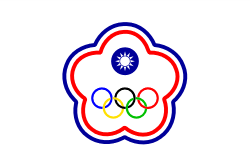
The ROC flag is not commonly seen at international gatherings in which the PRC participates due to pressure from the PRC over the political status of Taiwan and resulting minimal political influence of the ROC in such circles. Instead, the ROC is usually represented under a pseudonym (usually " Chinese Taipei") and flies a flag specifically designed for the organization. The design of the flag is the ROC logo centered on a white background. This is to avoid contradicting the PRC's position that the ROC is a defunct entity and that the ROC on Taiwan is illegitimate. The ban also effectively applies to spectators—during a Table Tennis final match at the 1996 Atlanta Olympics, police arrested a Taiwanese student for waving the ROC flag.
However, the symbolism of the flag began to shift in the early 21st century as there was a warming of relations between the pan-Blue coalition in Taiwan and the Communist Party of China on mainland China. The flag of the Republic of China has begun to symbolize the existence of a past and possibly future unified China, and as such the government of the PRC has made it clear that for Taiwan to change the flag would be a major provocation in favour of Taiwan independence. The ambiguity surrounding the flag was made apparent during the trip of Kuomintang Chairman Lien Chan to mainland China in April 2005, during which the flag was very prominently displayed at ceremonies honoring Sun Yat-Sen at which both KMT party officials and government officials from the PRC were in attendance.
The use of the flag in Taiwan reflects the controversy behind its symbolism. Although moderate supporters of Taiwan independence, such as President Chen Shui-bian, will display and salute the flag on formal official state occasions, it is never seen at political rallies of the Democratic Progressive Party. This is not only because of its association with mainland China but also because the flag contains design elements of the KMT party flag. By contrast, the ROC flag is always extremely prominent at political rallies of the pan-Blue coalition. This difference extends to the colors seen at the rallies. Rallies of the pan-Blue coalition give prominence to the colors of the ROC flag, with very large amounts of blue and smaller amounts of red. Rallies of independence-leaning parties are filled with green, with no blue or red at all.
More strident supporters of Taiwan independence, including former president Lee Teng-hui, have called for the abandonment of the flag, and there are a number of alternate designs for a specifically Taiwanese flag. However, the prospects for this are not high given that changing the flag requires a constitutional amendment; that the current flag has a huge amount of support among pan-Blue supporters and grudging acceptance among moderate independence supporters; and because changing the flag might cause political tension with the PRC. During the 2004 ROC legislative elections, it was briefly suggested that if the pan-green coalition won the elections that it would force the KMT to change the party emblem to be different from the flag. This proposal generated a few days of controversy and was then quickly forgotten.

